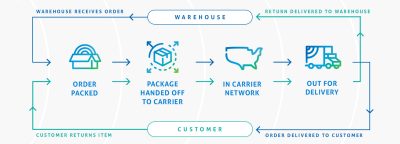What is E-commerce Logistics?
Ecommerce logistics, sometimes referred to as elogistics, is the process an ecommerce brand uses to get an order out the door and into the hands of the customer. After shoppers make an online purchase, the order is packed, shipped, delivered, and, in some cases, returned.
Although this process differs for every company, the ecommerce logistics of an online store includes several components.
The components of an ecommerce logistics supply chain
Ecommerce logistics is a complex multi-step process. Each component is reliant on the others and ecommerce brands must ensure that each of them is running smoothly to get online orders to customers quickly and efficiently.

Ecommerce order fulfillment
Ecommerce fulfillment involves all the steps in the ecommerce logistics process that occur within a warehouse up to the shipping stage. These can include warehousing, storage, packing, and handing off the order to the carrier. This also includes inventory management across other warehouses within the ecommerce supply chain.
The ecommerce fulfillment process is also the part of the supply chain that has the greatest impact on the customer’s unboxing experience. During the fulfillment process, an ecommerce brand can dictate what packaging and packing materials get used, what free samples get included, and which carrier will ship the order.
The fulfillment process allows a brand to connect with the customer through the online transaction and can impact how a customer perceives the brand.
Inventory management
No matter if you have a single warehouse or several, things can get very messy without proper ecommerce inventory management. By properly tracking what merchandise is situated in which warehouse, employees can keep supply levels in check based on current and predicted demand. With proper inventory management, online orders can get shipped faster and online shoppers can avoid waiting for their items.
Inventory management becomes especially important if an ecommerce brand sells shoes, apparel, or any item that is available in multiple sizes and colors. They’ll need to ensure that they have the right inventory management software and warehouse management software in place to find and track merchandise across their entire supply chain network. Ecommerce brands can also outsource their inventory management process to a trustworthy 3PL partner who can handle these activities on their behalf.
Ecommerce warehousing
An ecommerce brand needs additional space to keep inventory in stock when sales are growing. When selecting a warehouse, they’ll need to consider how much inventory to keep in stock, and where in the world they want inventory stored. An ecommerce brand needs to ensure that it can communicate with the other parts of the supply chain. This ensures that the right levels of inventory are maintained and that customers are not left waiting for their orders.
Another important factor that an ecommerce brand needs to consider is warehouse location. When merchandise needs to travel from a fulfillment center to a transportation hub, it can add time to tight delivery windows. Where a warehouse is located can be a big factor when it comes to calculating shipping times and delivering orders to customers on time.

Order packing and shipping
Order packing goes beyond just ensuring the right products are in the box. Once the order has been processed, a shipping carrier will be selected. Sometimes the customer can select a specific shipping option (if offered), but in most cases, the warehouse management system will decide. The order will then be gathered and packed by an employee who will apply the shipping label afterwards.
The packer preparing the box needs to know how to protect fragile items, which packing materials to use for specific items, and what free samples to include when required. If the package requires kitting, they’ll need to know which items go into the box together.
When an ecommerce brand is using a 3PL warehouse, they’ll need to ensure that their logistics partner can accommodate any personalized packaging the company wishes to use.
Ecommerce returns and reverse logistics
With so many shoppers returning items they bought and expecting a speedy refund, the ecommerce returns process is becoming a very important part of the post-purchase experience. Online companies need to ensure their reverse logistics are just as well-oiled as their fulfillment process. Lost packages can lead to delayed refunds, which can affect customer satisfaction. Lost items can also result in a double loss, as those products can no longer be resold after having already issued a refund.
What is an ecommerce supply chain?
An ecommerce supply chain is the set of systems, processes, and infrastructure that supplies the product and delivers it to the customer. It is the overall chain that dictates the logistics of an online store.
An ecommerce supply chain includes the manufacturer, the inventory management system, the warehouses, the distribution center, the fulfillment center, the delivery carrier, and more. As an ecommerce brand, it is important that every link in the supply chain is running as efficiently as possible. Not only is this more cost-effective, but it also keeps online shoppers happy.
Deliver a better brand experience
Looking for solutions to keep up with ecommerce demand? Pitney Bowes can make running your business a little easier. Explore Ecommerce Services
